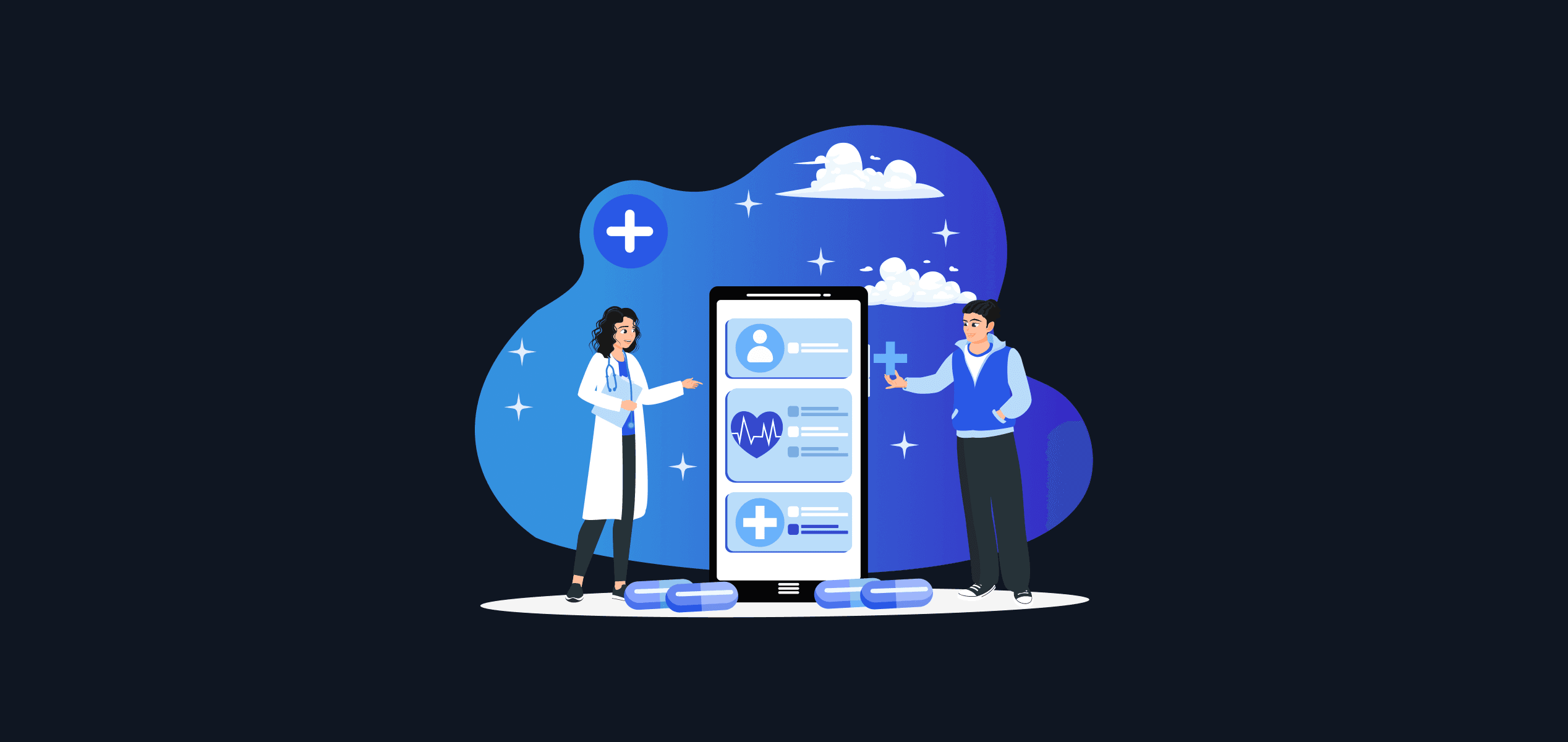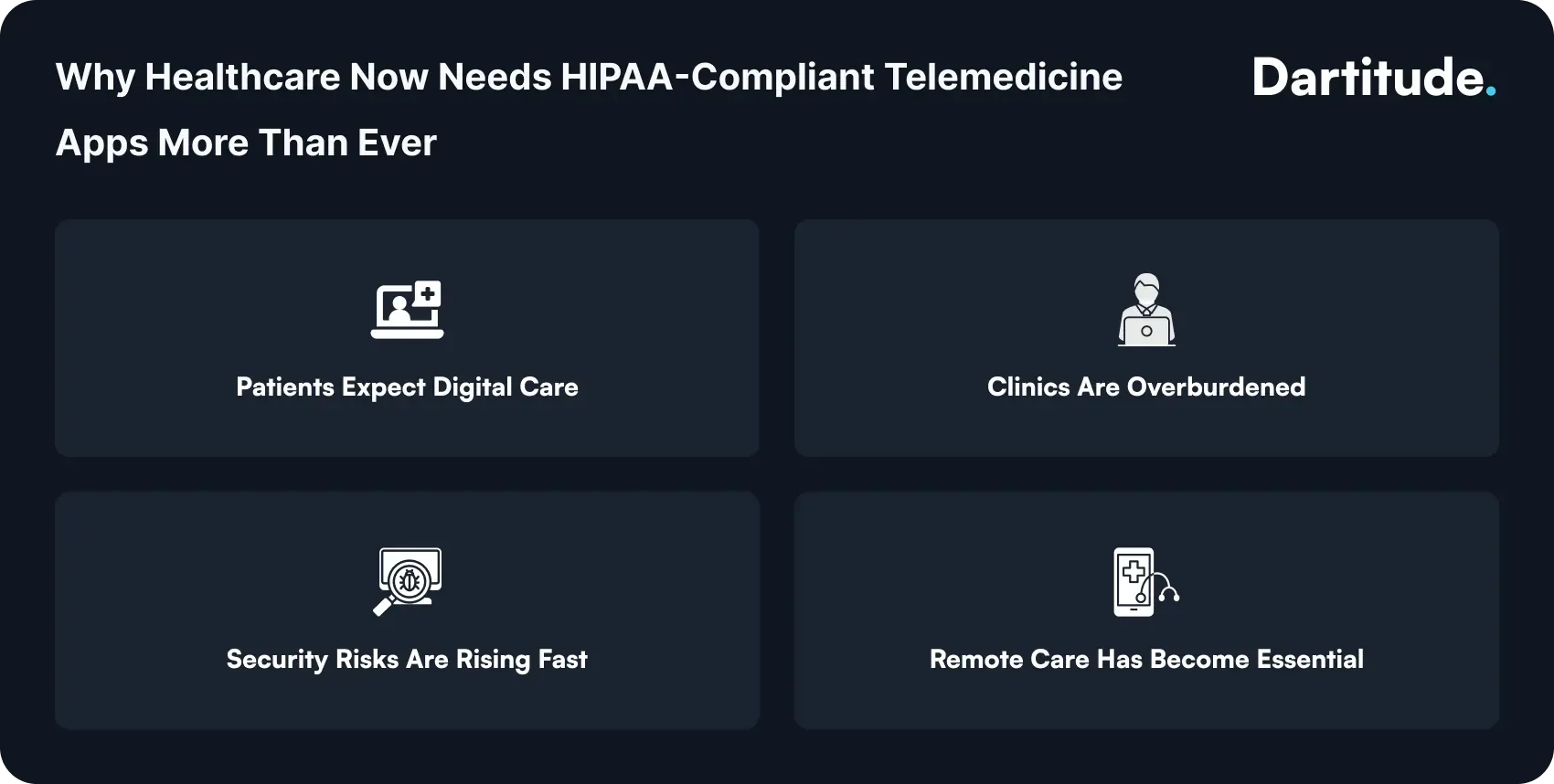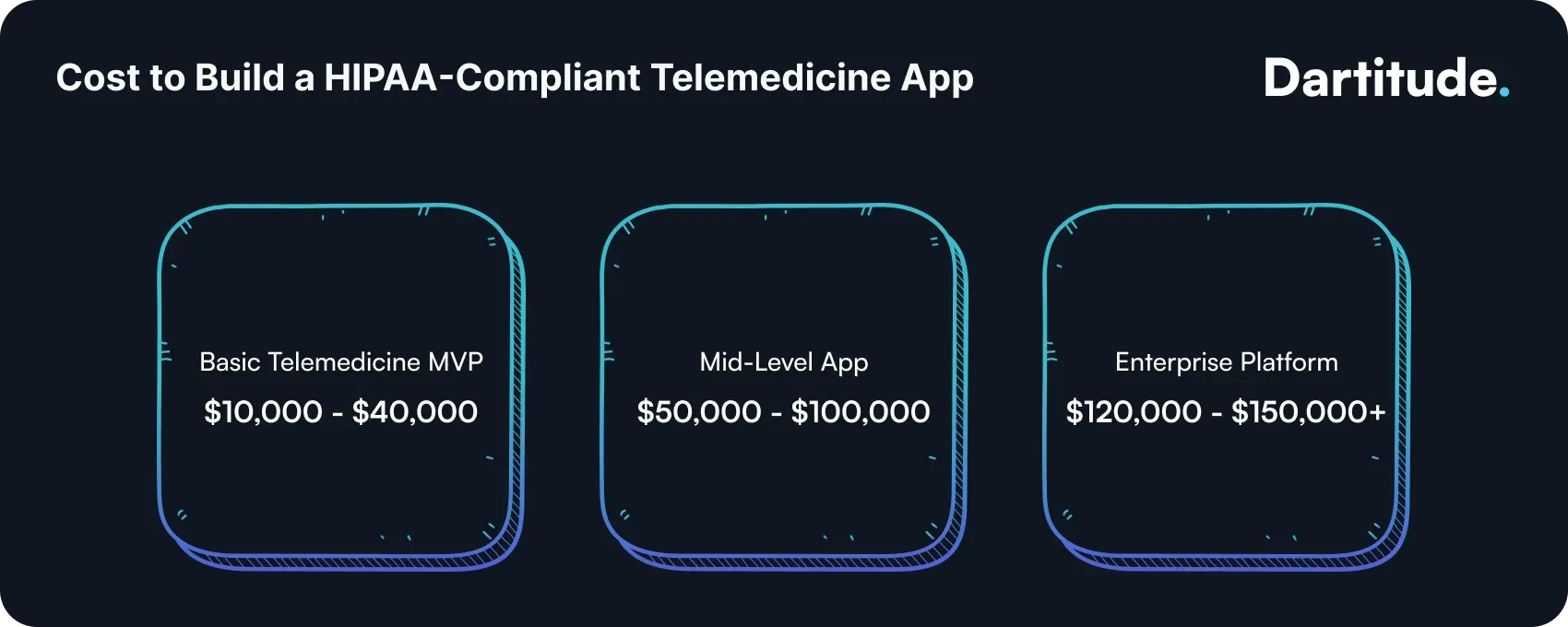
Build HIPAA Compliant Telemedicine App with Flutter: Complete Guide for 2025
I still remember one of my clients, a wellness center in Texas, that delivered great patient care but struggled behind the scenes.
The reason was due to slow billing, loads of paperwork work and a long queue of check-in processes that were holding them back.
Hectic situation, isn't it?
So I stepped in and helped them build a fully HIPAA-compliant telemedicine app, which was able to do faster check-ins, encrypted data sharing, and automated digital workflows.
That was the phase where I understood the increasing demand for HIPAA-compliant telemedicine apps.
In this blog, we’ll break down exactly how you can build a secure, scalable, and complete HIPAA-compliant telemedicine app for 2025 and beyond.
Why Healthcare Now Needs HIPAA-Compliant Telemedicine Apps More Than Ever

If you're aiming to build a HIPAA-compliant telemedicine app, there’s never a right time. Here’s why the demand is rising at a pace:
1. Patients Expect Digital Care
Patients now mostly go for online consultations for non-emergency issues.
A well-protected, smooth telemedicine app, built with strong HIPAA controls and modern cross-platform app development practices, ensures patients get care anytime, anywhere, without the impact on privacy and quality.
2. Clinics Are Overburdened
Through the implementation of HIPAA-compliant telemedicine apps, healthcare sectors can minimise the administrative tasks and thus increase the time that can be invested more in actual patient care and informative decision-making.
A HIPAA-compliant telemedicine solution automates these workflows through:
- Digital check-ins
- Online documentation
- Secure e-prescriptions
- Faster billing and approvals
Thus, telemedicine eliminates this load through automated workflows and online documentation.
3. Security Risks Are Rising Fast
Recorded $10.93 million per incident, healthcare encounters the highest data breaches. With increasing cyberattacks globally, they make platforms with unsecured servers, riskier for providers. With HIPAA-compliant apps, they ensure that PHI, also known as Protected Health Information, remains protected and fully controlled.
4. Remote Care Has Become Essential
Yes, nowadays, every patient wants a health-related consultation over the phone or a video conference. As they prefer to avoid traveling, especially aged patients.
They want care that’s:
- Convenient
- Safe
- Fast
- Accessible from home
HIPAA Compliance in Telemedicine Apps, What You Must Know (2025 Breakdown)
Here is a complete breakdown of a HIPAA-compliant telemedicine app HIPPA compliant.
1. Secure PHI Lifecycle Management
HIPAA needs Protected Health Information to be protected from the stage where it's collected until it’s deleted. Telemedicine apps must gather data, which is a priority, with consent and secure it using HTTPS/TLS.
2. Encrypted & Compliant Cloud Storage (Data at Rest)
Critical healthcare data to be stored on secure cloud platforms only, such as Google Cloud, AWS, or, more specifically, signed via BAA. AES-256 to be implemented, and all crucial information to be stored inside access control databases.
3. End-to-End Secure Communication (Data in Transit)
Your telemedicine app should protect the communication, whether doing it through different formats such as audio, pre-consultations, video, or more. This can be done by TLS 1.2+ and secure streaming protocols such as SRTP. End-to-end encryption ensures high security protocols.
4. Protected User Interface & Screen-Level Security
HIPAA needs to safeguard the display, as display leaks are increasing. Critical information to be masked in the notification, and the app must auto-lock when minimized or idle. Block the screenshot if taken, to project the data.
Dive Deeper: Flutter healthcare app development guide
5. Role-Based Access, Zero-Trust & Controlled Data Sharing
It is critically important to follow the rules strictly, so only authorized users can view specific protected health information. Role-based access and zero trust will help improve the security at the core.
6. Audit Trails and Real-Time Alerts (Important in 2025)
HIPAA now properly requires continuous monitoring, not checking only every week. Telemedicine apps should maintain details for every update, download, or modification of PHI. Real-time alerts are there to detect unwanted or suspicious behavior, such as multiple logins.
7. AI & Automation Safeguards (New Trend)
With the use of AI for diagnosis support and patient insights, HIPAA mandates strict controls:
- AI models should not be trained on PHI without explicit consent
- All outputs must be encrypted.
- Third-party AI APIs must be HIPAA-ready and BAA-enabled
Key HIPAA Required Safeguards
| Safeguard | What It Means |
| Administrative | It includes audits, access roles, and employee training |
| Technical | Focuses on encryption and secure login |
| Physical | Secure servers, controlled access to devices |
Any app managing PHI, telemedicine, scanning apps, and EHR apps should follow these. This is the main rationale why developing a HIPAA-compliant app has become mandatory for all.
You can also read our guide on : Flutter AI Integration
Why Choose Flutter to Build a HIPAA-Compliant Telemedicine App?

Selecting the right tech stack is important in healthcare speed, security, and loyalty affect patient care.
Let's see why Flutter is used to build a HIPAA-compliant telemedicine App.
1. Faster Development, Lower Cost
Through Flutter's feature of working within a single codebase, it enables you to build iOS, web Android apps from a unified platform. It simply mimics your development time by 50-55%. This assists founders in launching their MVPs more quickly without messing up with quality.
2. Native-Like Performance
If you want your telemedicine app to run with smooth UI updates, real-time video without any lag, then strong performance is needed as a core priority. It is the main reason why Flutter is the go-to framework, as its rendering engine avoids lag, as seen in several hybrid frameworks.
3. Strong Security Foundation
Security practices such as SSL pinning, isolation-based secure computations, and all are backed by Flutter. It easily gets integrated with native encryption libraries for keeping PHI safe. It, however, helps in meeting HIPAA’s technical safeguards more reliable way.
Next Up: Why Flutter for healthcare apps
4. Long-Term Scalability
Yes, with Flutter you can easily add new features without rewriting the code due to to architecture. This keeps the product expandable as clinical needs grow.
5. Strong Community & Healthcare Libraries
With a larger and growing global community of Flutter, it has a mature ecosystem with stable packages for secure storage, APIs that are common in healthcare. A larger community reflects faster problem-solving and regular updates.
Flutter vs React Native for HIPAA Compliant Mobile App Development
Deciding between Flutter vs React Native for secure healthcare apps? It’s about not only choosing the tech stack but also about how safely each framework handles PHI, encryption, and native controls. Here’s a quick comparison.
| Feature | Flutter | React Native |
| Performance | Uses the Skia rendering engine, smoother animations, and no JS bridge delays under encrypted workloads. | Dependent on the JavaScript bridge, it can experience frame drops when handling real-time video or encrypted data. |
| Security | Strong, fewer external dependencies, and tighter control over native code. | Good, but relies on more third-party packages |
| MVP Speed | Faster, fewer bugs, consistent UI | Slightly slower debugging |
| Cost | Lower development cost due to the unified UI system. | Moderate- effort in debugging is needed. |
| Audit Logging Support | Easier to integrate structured audit logs using a unified Dart layer | Requires handling logs across JS + native layers, increasing complexity. |
| Scalability (Enterprise Use) | Strong and provides predictable performance at scale, good for large clinical systems. | Good, but performance changes based on how many native modules are applied. |
Verdict: For a HIPAA-compliant telemedicine app, Flutter provides you with strong performance, higher security, and faster MVP delivery. If aiming to develop a secure, scalable healthcare product, exploring Flutter app development services will benefit you with both development speed and regulatory compliance.
Core Features Required to Build a HIPAA-Compliant Telemedicine App

There are several features to be noted down, needed to build a HIPAA-Compliant Telemedicine app, mentioned below:
1. Secure User Authentication (MFA) - Multi-factor authentication
Authentication must be done by the users via phone/email login or biometrics to prevent unknown access. You can also add MFA as a protection layer, assuring only verified users manage protected health information. Focus on using OAuth 2.0, JWT tokens, and biometric APIs.
2. Encrypted Video Consultations
For video consultations, they must run on providers like Agora, Vonage, and more. This type of service supports well-secured access control, encrypted screening, and protected media handling to protect real-time consultations.
3. Secure Chat & File Sharing
A telemedicine app should have a secure chat and file sharing to be encrypted and never to be stored in divide galleries. Automatically logging lean-ups prevents you from revealing sensitive data or medical information.
4. Patient Medical Profile
The app should protect users/patients' medical profiles, which include information such as allergies, past prescriptions, and previous visits. Also profile is to be synced so that it ensures accurate diagnosis while maintaining strict role-based access to PHI.
5. Role-Based Access Control (RBAC)
Make sure to restrict visibility of PHI on user types- patients, doctors, and staff in order to reduce unknown access and or data exposure.
6. Automated Backup & Disaster Recovery
When going for HIPAA-compliant, it needs encrypted backups so that the data of the patient is never lost for any reason. Your app should be able to restore the information faster during system failures.
7. Secure Cloud Hosting with BAA (Business Associate Agreement)
Make sure apps work with cloud platforms such as AWS, Azure, or GCP. A signed BAA ensures the cloud provider is properly working as per security rules. This keeps PHI protected at the server and infrastructure level. A signed Business Associate Agreement (BAA) ensures the cloud provider follows HIPAA guidelines for:
- Server encryption
- Network security
- Access logging
- Infrastructure compliance
Cost to Build a HIPAA-Compliant Telemedicine App in 2025

The cost to build a HHIPAA-compliant telemedicine app in 2025 varies from basic features to advanced.
Let's see the cost breakdown:
1. Basic Telemedicine MVP: $10,000 – $40,000
Best for early-stage startups validating an idea. Includes:
- Secure login & user authentication
- One-to-one video calls
- Basic chat & file sharing
- Essential PHI protection (TLS, basic encryption)
2. Mid-Level App: $50,000 – $10,0000
Best for growing clinics or health-tech startups looking for advanced features. Includes:
- EHR/EMR integration
- Advanced chat with encrypted media handling
- Appointment scheduling & e-prescriptions
3. Enterprise Platform: $120,000 – $150,000+
Built for hospitals, multi-clinic systems, and large-scale providers. It involves:
- AI triage, symptom analysis, or automation
- Analytics dashboard & detailed reporting
- Multi-provider workflows
A scalable telemedicine app, when built with the right tech stack, provides you with high ROI through reduced no-shows and faster follow-ups.
If you're considering Flutter for development, this is the phase to hire Flutter app developers who follow HIPAA rules, protected architecture, and healthcare integrations.
Final Takeaway: Your Path to a Safer Telemedicine App
Building a HIPAA-compliant telemedicine app is not an easy task and starts before development. Initiates with your clear vision, the problem you want to solve, and mapping the user journey. Once this foundation is set, choosing the right tech stack becomes the main objective.
The recommended framework for such apps is Flutter. Why?
Flutter gives you a strong performance, native-level security, and rapid development.
Planning to build an advanced telemedicine app?
Dartitude Labs provides the expertise and skills needed to launch faster, without compromising on security or quality.
If you're ready to build a telemedicine user-centric app, Flutter is your smartest choice to go for.
FAQs
1. What is the timeline of building a HIPAA-compliant telemedicine app?
According to me, an MVP can take 8–12 weeks, while a fully scalable platform with advanced features can take 4–6 months, based on the level of project timeline, complexity, and integrations.
2. Can Flutter apps meet full HIPAA compliance?
Yes. Flutter integrates well with native encryption, secure storage, SSL pinning, and compliance-ready cloud platforms. It completely supports HIPAA technical safeguards properly.
3. What integrations are essential for telemedicine apps?
Several integrations are critically important, which include video SDKs (Agora/Vonage), payment gateways, e-prescriptions module, and more.
4. What are the biggest HIPAA risks in telemedicine apps?
When going for HIPAA-compliant app development, there are many HIPAA risks in telemedicine apps that can affect your long-term stability, such as missing encryption, non-compliant notifications, and more.
5. Do I need a BAA for every third-party service used?
Yes. Any service handling PHI cloud storage, video API, and communication tools must sign a Business Associate Agreement (BAA) to meet HIPAA requirements.



